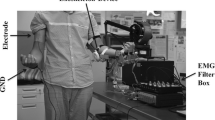Abstract
A biomechanical musculo-skeletal model of upper limb is presented in this paper, which can provide accurate representations of muscles and joints, and capture important interactions between joints. The upper limb model is made up of seven segments: ribs, sternum, clavicle, scapular, humerus, radius and ulna, considered as a single rigid body respectively and includes 22 muscles. The individual muscle forces can be calculated by using an electromyography (EMG) assisted method, which is verified by comparing the simulation results with other researches of an elbow flexion motion. These comparisons show that the muscle forces and the estimated joint moment match well with previous literatures.
Similar content being viewed by others
References
Erdemir A, Mclean S, Herzog W, et al. Model-based estimation of muscle forces exerted during movements [J]. Clinical Biomechanics, 2007, 22(2): 131–154.
An K N, Kwak B M, Chao E Y, et al. Determination of muscle and joint forces: A new technique to solve the indeterminate problem [J]. Journal of Biomechanical Engineering, 1984, 106(4): 364–367.
Pandy M G, Zajac F E, Sim E, et al. An optimal control model for maximum-height human jumping [J]. Journal of Biomechanics, 1990, 23(12): 1185–1198.
Savelberg H H C M, Herzog W. Artificial neural networks used for the prediction of muscle forces from EMG-patterns [C]//Proceedings of the XVth Congress of the International Society of Biomechanics. Finland: [s. n.] 1995: 810–811.
Lloyd D G, Besier T F. An EMG-driven musculoskeletal model to estimate muscle forces and knee joint moments in vivo [J]. Journal of Biomechanics, 2003, 36(6): 765–776.
Feng J M A F T, Koo T K K. A surface EMG driven musculoskeletal model of the elbow flexion-extension movement in normal subjects and in subjects with spasticity [J]. Journal of Musculoskeletal Research, 1999, 3(2): 109–123.
Koo T K K, Mak A F T. Feasibility of using EMG driven neuromusculoskeletal model for prediction of dynamic movement of the elbow [J]. Journal of Electromyography and Kinesiology, 2005, 15(1): 12–26.
Wang Cheng-tao. Mechanical virtual human of China [J]. Journal of Medical Biomechanics, 2006, 21(3): 172–178 (in Chinese).
Maurel W, Thalmann D. A case study on human upper limb modelling for dynamic simulation [J]. Computer Methods in Biomechanics and Biomedical Engineering, 1999, 2(1): 65–82.
Pennestri E, Stefanelli R, Valentini P P, et al. Virtual musculo-skeletal model for the biomechanical analysis of the upper limb [J]. Journal of Biomechanics, 2007, 40(6): 1350–1361.
Morrey B F, Chao E Y S. Passive motion of the elbow joint: A biomechanical analysis [J]. Journal of Bone and Joint Surgery: Series A, 1976, 58(4): 501–508.
Chao E Y, Morrey B F. Three-dimensional rotation of the elbow [J]. Journal of Biomechanics, 1978, 11(1–2): 57–73.
Youm Y, Dryer R F, Thambyrajah K, et al. Biomechanical analyses of forearm pronation-supination and elbow flexion-extension [J]. Journal of Biomechanics, 1979, 12(4): 245–251.
Hollister A M, Gellman H, Waters R L. The relationship of the interosseous membrane to the axis of rotation of the forearm [J]. Clinical Orthopaedics and Related Research, 1994, 298: 272–276.
Van Der Helm F C T, Veenbaas R. Modelling the mechanical effect of muscles with large attachment sites: Application to the shoulder mechanism [J]. Journal of Biomechanics, 1991, 24(12): 1151–1163.
Epstein M, Hertzog W. Theoretical models of skeletal muscle [M]. England: John Wiley and Sons Press, 1998.
Garner B A, Pandy M G. Estimation of musculotendon properties in the human upper limb [J]. Annals of Biomedical Engineering, 2003, 31(2): 207–220.
Zajac F E. Muscle and tendon: Properties, models, scaling, and application to biomechanics and motor control [J]. Critical Reviews in Biomedical Engineering, 1989, 17(4): 359–411.
Hermens H J F B, Merletti R. European recommendations for surface electromyography [M]. Netherlands: Roessingh Research and Development Press, 1999.
Cutter N, Kevorkian C G. Handbook of manual muscle testing [M]. New York: McGraw-Hill Press, 1999.
Raikova R. A model of the flexion-Extension motion in the elbow joint-Some problems concerning muscle forces modelling and computation [J]. Journal of Biomechanics, 1996, 29(6): 763–772.
Raikova R T, Aladjov H T. Hierarchical genetic algorithm versus static optimization-Investigation of elbow flexion and extension movements [J]. Journal of Biomechanics, 2002, 35(8): 1123–1135.
Author information
Authors and Affiliations
Corresponding author
Additional information
Foundation item: the National Natural Science Foundation of China (No. 30530230)
Rights and permissions
About this article
Cite this article
Zhang, Ll., Zhou, J., Zhang, Xa. et al. Upper limb musculo-skeletal model for biomechanical investigation of elbow flexion movement. J. Shanghai Jiaotong Univ. (Sci.) 16, 61–64 (2011). https://doi.org/10.1007/s12204-011-1095-6
Received:
Published:
Issue Date:
DOI: https://doi.org/10.1007/s12204-011-1095-6




